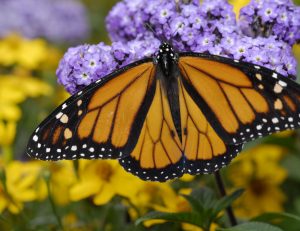
Florida Museum of Natural History photo by Jeff Gage
GAINESVILLE, Fla. — Many young children today are disconnected from the natural world, but a project to plant local butterfly gardens in area schools is closing the gap that exists between urban students and nature.
Florida Museum of Natural History scientists partnered with educators at Duval Elementary School last fall to open children’s eyes to the unique metamorphosis that occurs during butterfly development and the responsibilities involved in caring for a garden. Now, the museum is raising funds and accepting plant donations for gardens at other schools, including a project at Williams Elementary School set to begin this fall.
“We live in an environment where kids do not have enough exposure to nature in order to learn how it operates,” said Duval teacher Anterria Ellerbe. “Thanks to the garden, these students do not take the natural world around them for granted anymore.”
Andrei Sourakov, a lepidopterist at the Florida Museum on the University of Florida campus, is hopeful the project will gain community support and lead to butterfly gardens at other schools. He said he believes with technology ever-advancing and natural habitats declining worldwide, the distractions that keep kids indoors are increasing while the opportunities to directly experience nature are decreasing.
“I think co-existing with nature is something that is acquired through experiences,” Sourakov said. “This has to start with children and is best learned through outdoor experiences such as planting a butterfly garden. It is important that we begin to better appreciate wildlife, otherwise, development will continue to occur in places that should be conserved.”
The garden at Duval is teaching students how to be good stewards of the environment and providing them with a sense of accomplishment and responsibility, Sourakov said. He instructed the third-graders on how to care for the garden, and plant biology and entomology were integrated into the class’ science curriculum throughout the school year.
Ellerbe said students also kept a journal of their experiences in the garden and documented their newfound awareness of wildlife, including the life cycle of butterflies.
Recently, the students at Duval got their hands dirty again with more than 20 additional plants donated to the butterfly garden during the Florida Museum’s Earth Day celebration. The garden includes nectar sources and host plants, on which butterflies lay their eggs.
The City of Gainesville received its “Butterfly City” certification in 2009—the first awarded in the nation—as part of an effort to conserve Lepidoptera in urban areas. Sourakov is hopeful local scientists and the Gainesville community will continue to strengthen the city’s status by planting butterfly gardens and bringing the classroom outside.
“Educators and scientists serve the community with the work they do at the museum through our world-class exhibits, lecture programs and camps,” Sourakov said. “But we can also occasionally go out into the community and teach young people about biodiversity.”
Donations to the school butterfly garden program may be made online, www.uff.ufl.edu/appeals/Sourakov, by visiting the Florida Museum’s plant sale between 10 a.m. and 5 p.m. Monday through Saturday, or 1-5 p.m. on Sunday, or calling the Museum Collectors Shop, 352-273-2041.
-30-
Writer: Stephenie Livingston, slivingston@flmnh.ufl.edu
Source: Andrei Sourakov, 352-273-2013, asourakov@flmnh.ufl.edu
Media contact: Paul Ramey, 352-273-2054, pramey@flmnh.ufl.edu